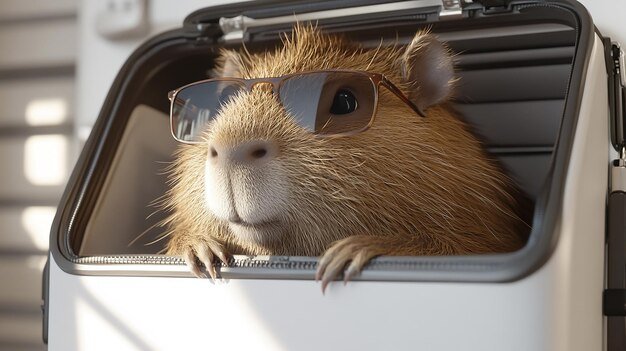Hamster and Sunroof: Your Hamster in a Car with a Sunroof

Pets have become some different options from animals to their owners; they are family members. As pet belonging is created, the yearning to bring our shaggy mates along on vehicle rides increases. Hamster and Sunroof Hamsters, yet little and delicate, are no exception to this example. In any case, not at all like canines or cats, hamsters require unequivocal thought and thought while being sent in a vehicle. One popular part of various state-of-the-art vehicles is the sunroof, offering a strategy for working on the driving experience for the two individuals and their pets. However, how does a sunroof impact the prosperity of a hamster making the rounds? Might you anytime safely transport a hamster while participating in the benefits of a sunroof? In this article, we’ll examine the basic considerations for driving with a hamster and a sunroof, ensuring both security and comfort for your pet Hamster and Sunroof.
Understanding Hamster Prosperity During Vehicle Rides
Hamsters, being little rodents, are altogether more fragile to their natural variables than greater pets. The racket, development, and temperature changes inside a vehicle can cause tremendous tension for your Hamster and Sunroof. Thus, it is vital to plan any vehicle trips with your pet carefully.
Hamster Stress and Strain
Hamsters are evening creatures and can turn out to be centered around during the day Hamster and Sunroof. Boisterous disturbances, unexpected turns of events, and new circumstances can be overwhelming for them. Keeping the ride notwithstanding how tranquil as conceivable might be huge. This consolidates driving at a reliable speed, avoiding plain music, and ensuring that the vehicle’s inside is pretty much as consistent as could truly be anticipated.
Authentic Vehicle

A protected and ventilated hamster carrier is major while moving your pet. The carrier should be strong and have adequate ventilation openings to stay aware of the wind current. It’s in like manner savvy to fix the lower part of the carrier with fragile sheet material to cushion your hamster from any shocks during the ride.
Temperature Control
Hamsters are sensitive to ludicrous temperatures Hamster and Sunroof. In a warm environment, the temperature inside a vehicle can quickly become hazardous, even with the sunroof open Hamster and Sunroof. Constantly ensure the temperature in the vehicle stays between 65°F to 75°F (18°C to 24°C), which is a pleasing reach for hamsters. Ponder uses the environment control framework or warming structure to keep an ideal environment.
The Occupation of a Sunroof in Hamster Transportation
A sunroof can add a level of excess to your vehicle rides, yet while transporting a hamster, it’s basic to grasp what this component can mean for your pet Hamster and Sunroof. The following are a couple of considerations to recall:
Ventilation Benefits
A sunroof can give additional ventilation, which could have all the earmarks of being significant for your hamster. Outside wind current can help with thwarting overheating, especially during more blazing months. Regardless, be aware of the breeze impacts and sudden temperature diminishes that can happen when the sunroof is open. Hamsters are nearly nothing and can be affected by cool air, so expecting that you will open the sunroof, it’s basic to do as such with some limitations Hamster and Sunroof.
Sunshine Receptiveness
Hamsters are evening and grade toward faint lighting. Receptiveness to facilitate light through a sunroof can cause trouble and regardless, overheating Hamster and Sunroof. Accepting the sunroof allows an over-the-top measure of light, it can lay out a clumsily amazing and warm environment in the vehicle. Consider using a shade or holding the sunroof somewhat shut to restrict direct sunlight receptiveness on your hamster’s carrier.
Wind and Upheaval
While driving with the sunroof open, the breeze upheaval can be altogether plain, especially at high rates. This could be troubling for a hamster, whose tricky hearing can get even slight disrupting impacts. If you genuinely choose to open the sunroof, try to drive at an all the more sluggish speed and keep the carrier in a space that is safeguarded from direct wind.
Security Concerns
While a sunroof can work on your driving experience, zeroing in on the prosperity of your hamster is crucial. Never place the hamster’s carrier very nearly an open sunroof. Despite the way that it’s particularly unrealistic for a hamster to escape from a strong carrier, disasters can happen, and leaving nothing to chance is for each situation better Hamster and Sunroof. The carrier should continually be securely fastened on the vehicle seat or floor.
The best strategy to Move a Hamster in a Vehicle with a Sunroof safely
While orchestrating a journey with your hamster, especially in a vehicle with a sunroof, there are a couple of stages you can take to ensure the outing is essentially as safeguarded and pleasing as plausible for your pet.
Set up the Carrier
Pick a particularly ventilated carrier with secure snares to hold your hamster back from moving away. The carrier should be tremendous enough for your hamster to move around yet minimal enough to prevent a great deal of sliding or tumbling during the ride. Add sensitive sheet material to the base to cushion your hamster from awkward obstructions.
Secure the Carrier
Ensure that the carrier is set in a consistent circumstance in the vehicle, ideally on the floor or lashed in with a seat strap Hamster and Sunroof. Make an effort not to put the carrier clearly under the sunroof or near any windows where sunlight could heat up within.
Limit Sunroof Use

In case you’re moving your hamster, it’s ideal to keep the sunroof shut or just somewhat open Hamster and Sunroof. This will decrease upheaval, wind, and direct sunshine receptiveness, laying out an all the more peaceful environment for your pet. Accepting you truth be told do open the sunroof, and ensure that the breeze current doesn’t make drafts that could impact your hamster.
Screen Temperature
Save the vehicle’s temperature inside a safeguarded go after your hamster. Accepting that the atmospheric conditions are too warm or too cool, close the sunroof and rely upon the vehicle’s current circumstance control structure to deal with the temperature.
Keep the Trip Short
Long vehicle outings can be upsetting for hamsters. If possible, keep the ride short and breakpoint stops or startling turns of events. The less time your hamster spends in a moving vehicle, the better.
Additional Tips for Hamster Security Making the rounds
Do whatever it takes not to Deal with Before the Trip: Hamsters have fragile stomach-related structures, and the development of a vehicle could make them debilitated Hamster and Sunroof. To avoid any normal issues, stop dealing with your hamster going before the excursion.
Bring Water: Hamsters can become dried out during long journeys, especially if the temperature in the vehicle differs Hamster and Sunroof. Attempt to bring a water bottle joined to the carrier so your pet can stay hydrated.
Calming Techniques: If your hamster will overall get fretful during vehicle rides, think about putting a piece of material or a towel over the carrier. This will help close out excess light and lay out an all-the-more tranquil environment for your hamster to loosen up in.
Conclusion
Transporting a hamster in a vehicle with a sunroof can be a silly experience, but it requires wary readiness and thought regarding your pet’s necessities. By ensuring that the carrier is secure, the temperature is controlled, and the sunroof is used honorably, you can make the journey as pleasing as serviceable for your hamster. Consistently review that hamsters are fragile creatures, and their security and thriving should be the principal worry during any trip Hamster and Sunroof. You and your hamster can participate in secured and pleasing vehicle rides together with the right protections.




